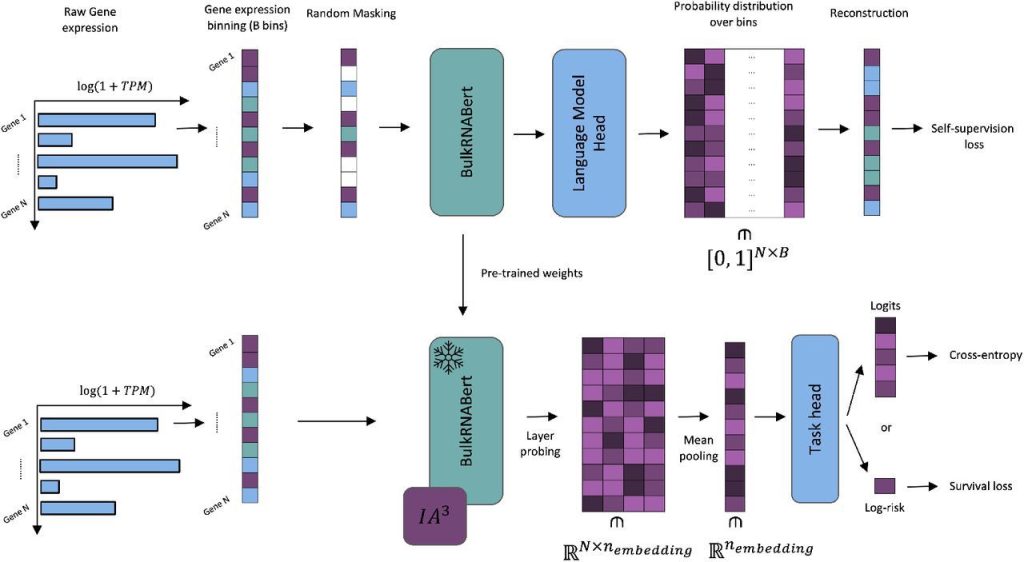Recent pioneering research by Université Paris-Saclay and Instadeep scientists has introduced a new technique, BulkRNABert. This method exploits a language model, an artificial intelligence (AI) that understands complex patterns to analyze bulk RNA-sequencing (RNA-seq) data to improve cancer prognosis. By diving into the symphony of gene activity in a tumor, BulkRNABert provides an exciting new way to uncover meaningful insights for better-informed treatment choices.
Cancer is a complex and often unpredictable disease. Accurately predicting its course and a patient’s prognosis is crucial for making informed treatment decisions. Traditionally, doctors rely on factors like tumor stage and pathology. However, recent advancements in artificial intelligence (AI) offer powerful new tools to unlock the secrets hidden within a patient’s genes. This blog examines BulkRNABert, a breakthrough technology that applies language models to analyzing bulk RNA-sequencing (RNA-seq) data for improved cancer diagnosis.
Breaking Down the Code of Life: RNA-seq and its Potential
However, our blueprints for building proteins hold a lot of information concerning our health and diseases. RNA-seq is a powerful technique that enables scientists to assess the activity of genes showing which are being turned on or off in different cells or tissues. Nonetheless, traditional analysis approaches face challenges due to the vast and complex nature of this data.
Decoding RNA-seq Symphony: Enter Language Models.
Imagine a language model that understands the intricate languages of a human gene. This is precisely what BulkRNABert does. It’s a transformer-based language model similar to those employed in natural language processing (NLP) tasks like machine translation. However, unlike words, BulkRNABert is trained on RNA-seq data, where gene expression levels are its vocabulary.
The researchers ingeniously convert the raw gene expression data into a sequence of tokens, each representing a particular range of expression levels. By analyzing these sequences, BulkRNABert learns about the underlying patterns and relationships between genes, thus effectively translating the symphony of gene activity into something it can understand as if it were talking to us.
BulkRNABert’s Two-Pronged Approach to Cancer
The researchers use BulkRNABert to execute two crucial cancer prognosis tasks:
- Classification of Cancer Types: It is essential to accurately identify the exact kind of cancer, as this will help select the best treatment method. Remarkably accurate predictions about the type of cancer can be made by BulkRNABert through RNA-seq analysis.
- Survival Analysis: In planning treatments, predicting how long a patient will survive after being diagnosed is crucial. BulkRNABert uses the RNA-seq data to estimate the duration a patient can live with the disease.

The Power of Pre-Training: Learning from Many to Excel for One
Like any student who needs a broad background before studying specific subjects, BulkRNABert pretrains on various RNA-seq datasets.
The models were trained using:
- Non-cancerous datasets (GTEx and ENCODE): This provides information about gene expression patterns in healthy individuals.
- Cancerous datasets (TCGA): This allows BulkRNABert to identify gene activity signatures unique to cancers.
Interestingly, it was found that pre-training on both non-cancerous and cancerous data produced better general performance. Hence, BulkRNABert can learn not only from normal gene expression but also from specific knowledge obtained from studying tumors.
Beyond Boundaries: Knowledge Transfer for Invisible Cancers
The most exciting feature of BulkRNABert is its ability to learn. For example, the trained pan-cancer models could help predict the prognosis of rare or less common malignancies. This is particularly important when there are limited data sets that cannot be uniquely applied to build a model. The study has proven that pan-cancer models perform excellently even on cancers that were not part of the training. Therefore, BulkRNABert can borrow knowledge across various cancer types, which can provide valuable insights into the prognosis of rare malignancies.
Looking Forward: AI-driven Cancer Prediction for Tomorrow
Even though BulkRNABert is a leap forward, it still leaves room for future research. These may include making fine adjustments to its per-cohort analysis (which refers to specific cancer types) and incorporating other forms of data like genomics and imaging, among others.
This is a future where AI-fueled RNA-seq data analysis by BulkRNABert becomes common in routines of cancer diagnosis and therapeutic planning.
Consequently, it may result in:
- More Accurate Prognosis: Making personalized treatment plans based on the tumor’s specific biology, BulkRNABert can offer a more complete picture of a patient’s cancer.
- Earlier Intervention: Forecasting improved survival can enable doctors to take action at an earlier stage when there is still potential for curing cancer.
- Better Treatment Decisions: With greater certainty about how the disease will progress in individual patients, doctors and individuals with cancer need to make choices regarding alternative treatments by considering their risks and advantages comprehensively.
Beyond Cancer: Potential Applications in Other Diseases
BulkRNABert’s basic principles are potentially applicable beyond tumors. Concurrently, similar language models could be developed to enhance diagnosis, prognosis, and treatment strategies for diverse health conditions by analyzing RNA-seq data from different diseases.
Join the Discussion
AI-powered healthcare is evolving very fast, and BulkRNABert is a huge addition. Anytime technology is introduced, some issues and factors demand dialogue. The following are some things to think about:
How do we ensure responsible and ethical development and implementation of AI tools in healthcare? What difficulties might one encounter when using AI for medical diagnoses or prognoses?
Your ideas, outlooks, and suggestions are welcome as comments below. Let’s keep the discussion going while exploring the fantastic possibilities of how AI could revolutionize healthcare and bring better results for patients.
Article Source: Reference Paper | Code is available on GitHub.
Important Note: bioRxiv releases preprints that have not yet undergone peer review. As a result, it is important to note that these papers should not be considered conclusive evidence, nor should they be used to direct clinical practice or influence health-related behavior. It is also important to understand that the information presented in these papers is not yet considered established or confirmed.
Follow Us!
Learn More:
Anchal is a consulting scientific writing intern at CBIRT with a passion for bioinformatics and its miracles. She is pursuing an MTech in Bioinformatics from Delhi Technological University, Delhi. Through engaging prose, she invites readers to explore the captivating world of bioinformatics, showcasing its groundbreaking contributions to understanding the mysteries of life. Besides science, she enjoys reading and painting.
















